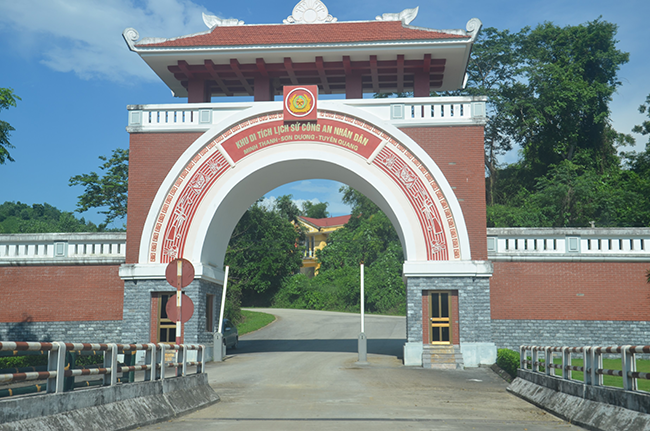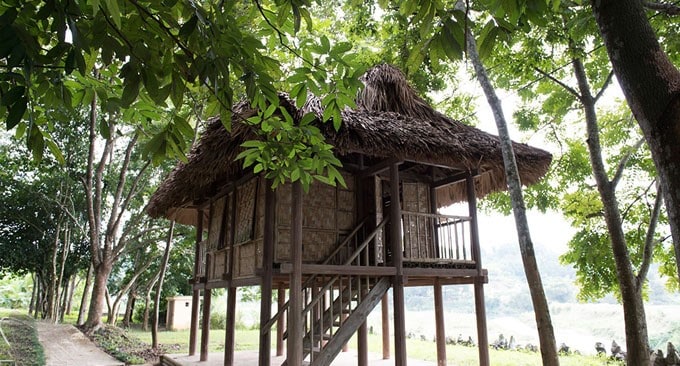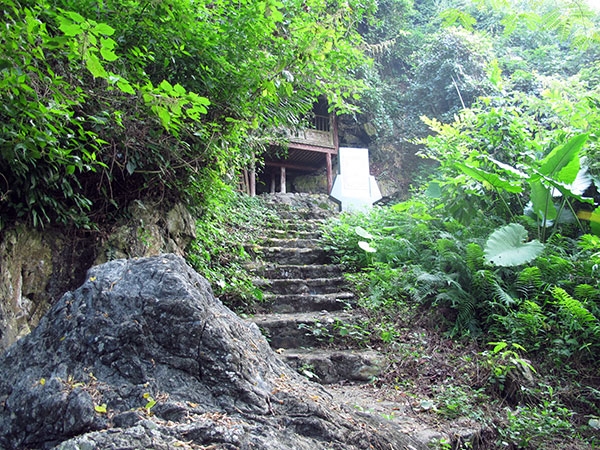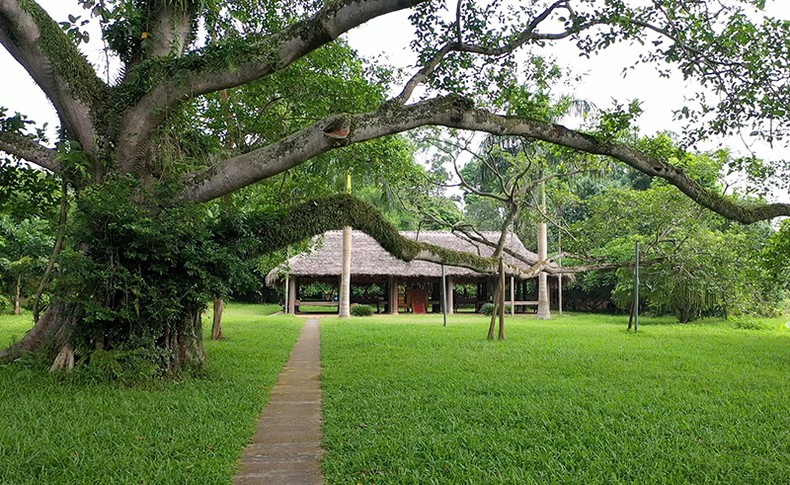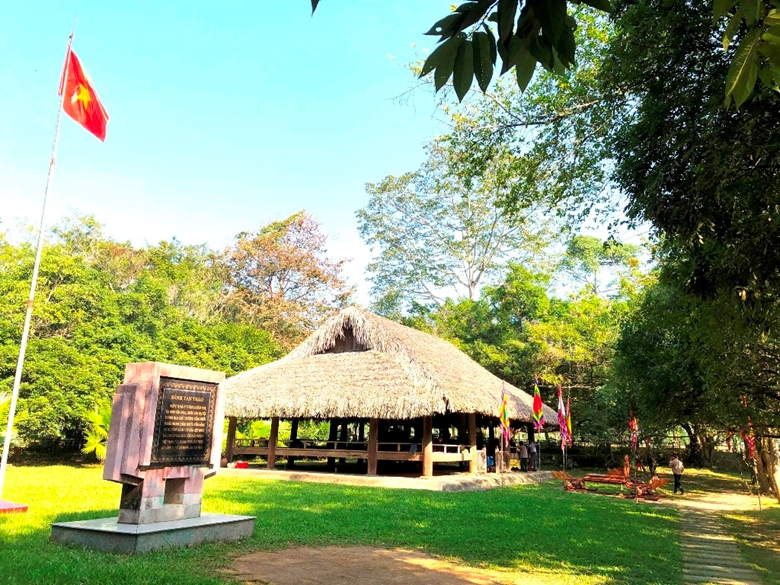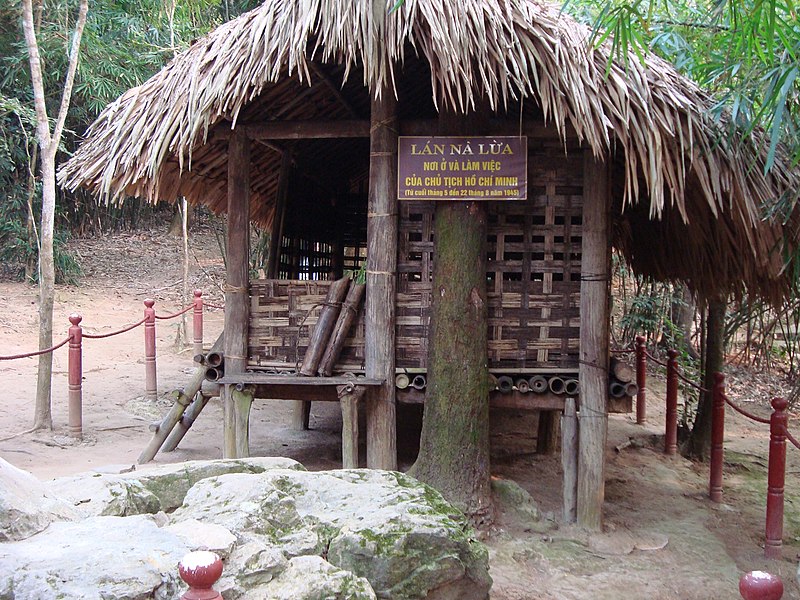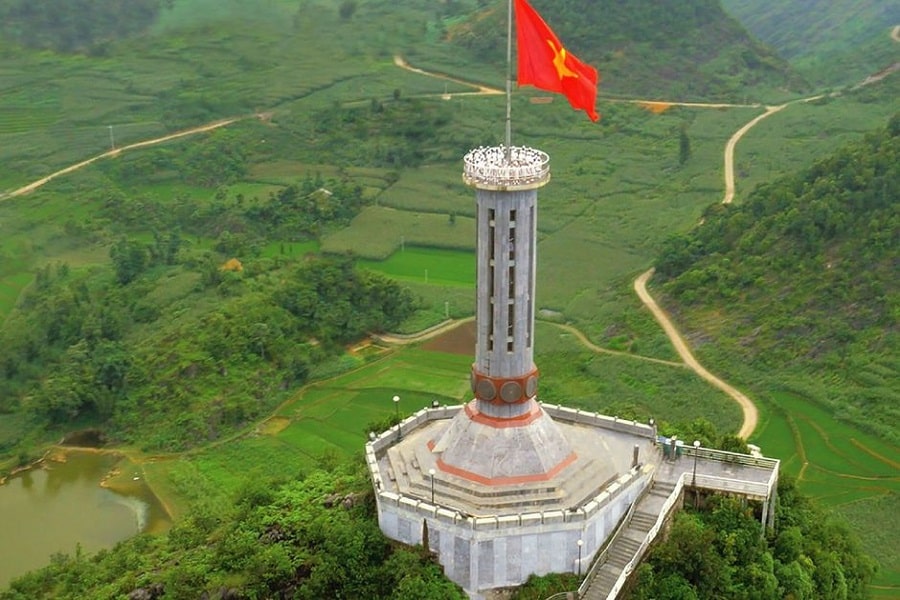Relic point Vietnam
Việt NamCultural and historical tourist destination of the Police Department
The Vietnam People's Police Historical Relic Area (Central Public Security Relics) in Dong Don village, Minh Thanh commune (Son Duong) is part of the Tan Trao Special National Historical Site, where residences and worked for the Central Police Department from April 1947 to September 1950. Previously, all the housing and work of the departments in the Central Police Department were distributed on two large hills, often called hills A and B. These two hills are located next to each other and close to Lung field. Stork. From here you can observe a large area of mountains and villages, convenient for traveling and meetings. Behind the two hills is surrounded by Temple Mountain. The hidden and dangerous terrain is very convenient for protection. This place has witnessed the growth steps of the entire force, where the Central Police Department issued important directives and resolutions, and where historical events of great significance to the People's Public Security took place. August 19 Square is named after the traditional CAND day. Prominent in front of the Square are the Fatherland flag and the Party flag built of natural stone with a strong position leaning against the mountain, representing the desire for the country and the Party to live forever. To show gratitude and traditional education for generations of People's Public Security officers and the Central Public Security Party Committee, leaders of the Ministry of Public Security had the names of 13,689 martyrs engraved on the memorial stele behind the two flags. The monument "Protecting national security", located on top of hill B, in the center of the relic site, has a complete weight of 420 tons. This is a unique cultural work that is not only valuable in terms of history and content but also has value in art, architecture, sculpture... The monument complex is nearly 3,000 m2 wide, made entirely of natural stone with the center being the Monument "Protecting Homeland Security" made of monolithic granite, with a height of 21.6 m, largest diameter of 4.5 m, facing the capital Hanoi. The monument includes 5 characters representing the forces participating in protecting national security. On the top is the National flag, the Party flag and a sword pointing towards the sky. Behind the Monument is a red granite relief depicting 39 events with selected images to most generally represent outstanding activities in fighting, building, and growing up. The People's Public Security force along with the entire people in the cause of protecting national security under the leadership of the Party. The bas-relief is a typical and unique cultural work honoring the process of formation and development of the Vietnamese People's Police. Looking from a distance, the relief can be seen like a cloud radiating a brilliant aura. With the purpose of educating the glorious traditions of the industry for every officer and soldier in the People's Public Security force, in 2010, along with the construction of the relief, the leaders of the Ministry of Public Security decided to engrave the name of the officer. 630 collectives and 336 individuals were awarded the title of Hero of the People's Armed Forces of the People's Public Security force on the gold panel on the back of the relief. Source: Tuyen Quang province electronic information portal
Tuyen Quang 4233 view
Relics of Comrade Ton Duc Thang's Housing and Safe Tunnel
The relic of Comrade Ton Duc Thang's House and Safe Bunker is located in Chi Lien village, (now Dong Ma village), Trung Yen commune, Son Duong district. Where comrade Ton Duc Thang, Acting Head of the Standing Committee of the National Assembly and Chairman of the Lien Viet Front, lived and worked from the end of 1952 to 1954. The house is located next to the Pho Day River, surrounded by lush greenery. good, helping to facilitate secret communication between places in the region. This is a wooden stilt house with 2 vertical compartments and a palm leaf roof. The outside of the house is the place to work and receive guests; The inner space is where Uncle Ho rests. Close to Uncle Ton's house is a safety tunnel dug about 10m deep into the Chi Lien mountainside, 10m horizontally, with 2 two-way doors. These are two typical relics among the revolutionary historical relics that were once associated with the revolutionary life of comrade Ton Duc Thang in Tuyen Quang during the arduous period of the resistance war against the French colonialists. Kim Quan relic site is more than 40 km east of Tuyen Quang town, spreading in the Na Loi and Vuc Nhu forests, Khuon Dien village, Kim Quan commune, Yen Son district. The Pho Day River surrounds the forest, making it convenient for transportation and living while also ensuring confidentiality. The Party Central Committee office area is 200m northeast of the Government Office. Here, there is a hall, the house of General Secretary Truong Chinh, the house of comrades Hoang Quoc Viet, Le Van Luong and parts of the Central Office: radio station, archives, library, and security guards. Vuc Nhu location where Uncle Ho lived and worked. Uncle Ho's house is a stilt house built on a mountainside. Not far from the stilt house is a shelter. The house is connected to the tunnel by a zigzag trench. The entire office, house, and hall are made of wood, bamboo, leaves... the shelters are dug deep into the mountain, covered with wood on all four sides. Particularly, the basement of the Party Central Committee office area has an exposed section on the outside, this part has a high mound, creating a zigzag-shaped entrance to the tunnel. Kim Quan is also the place where Uncle Ho, the Party Central Committee, and the Government receive international guests. From here, Deputy Prime Minister and Minister of Foreign Affairs Pham Van Dong went to attend the Geneva conference. The relic site has been ranked as a national monument by the Ministry of Culture and Information. Source: Vietnam Travel Association
Tuyen Quang 4321 view
Bong Cave
According to the book Historical relics - souvenirs of President Ho Chi Minh on Tuyen Quang land published by Tuyen Quang Department of Culture, Sports and Tourism in 2010, Bong cave, Bong village, Tan Trao commune (Son Duong) This is where President Ho Chi Minh stayed the longest during the resistance war. From a small, simple shack in front of Bong cave, Uncle Ho signed many important decrees, chaired many important meetings of the Government, wrote newspapers, and wrote poetry. During his days here, Uncle lived a simple and pure life, always giving care and love to everyone. At Bong Cave, Uncle Ho lived and worked 3 times: The first time from May 1951 to December 1951, the second time from January to April 1952, the third time from June to the end of 1952. . At Bong cave shack, despite being busy with thousands of jobs, Uncle Ho still spent time playing with the children, increasing production, and practicing sports. Every day, Uncle Ho still went to Pho Day river to bathe. When he returned, he did not forget to bring a few small stones to line the steps to make it less slippery on rainy days. Many touching stories about Uncle Ho's brilliant revolutionary qualities and love for officers, soldiers and people here are still told. From Bong Cave, President Ho Chi Minh set out to the location of the expanded Politburo meeting scheduled to take place on May 25, 1951. It was raining heavily, the stream water rose, he swam across the stream and soaked in the rain to get there. attend the meeting. Also here, Uncle Ho gave blankets and covers to protect the officers from the cold in the middle of a cold winter night, gave rice to the officers to eat to avoid hunger, and told the officers to sleep in the shacks to avoid fatigue. It was Uncle Ho's immense love that urged the cadres who lived near Uncle Ho to overcome all difficulties and hardships to complete the assigned tasks during the resistance war and forever after. Bong Cave Shack is also where Uncle Ho wrote many articles and articles on self-criticism and criticism, preventing bureaucracy, embezzlement, and waste. Three times President Ho Chi Minh lived and worked in Bong cave shack. He worked passionately, enthusiastically, without rest. Many orders and directives were issued and transmitted nationwide, leading the revolution to move forward steadily. Important decisions have changed the battlefield situation, diplomatic relations have been built and strengthened, bringing Vietnam's political position to new heights, financial and monetary work has been focused on creating strength for the resistance economy. From here, he set out on a business trip abroad, going to the front to direct the campaign. Source: Tuyen Quang Newspaper online
Tuyen Quang 4019 view
Hong Thai Communal House (Kim Trien Communal House)
Before 1945, Hong Thai communal house was also called Kim Chien communal house in Hong Thai village, Tan Trao commune. The communal house was built to meet the needs of cultural and religious activities of the community and was a place to meet and discuss important matters. common work of the village. In March 1945, under the leadership of the Party, directly comrade Chu Quy Luong, the people of Kim Chien rose up in an armed uprising to seize power. After gaining power, the people met and decided to change the name of the village. The people took the name of martyr Pham Hong Thai as the name of their commune and Kim Chien communal house has also been named Hong Thai communal house since then. Hong Thai communal house was built according to feng shui techniques passed down from ancient times, that is: "earth gathers water, water gathers". In fact, the communal house is placed in the south direction with Thia mountain as the communal house, in front is the Pho Day river, in front of the communal house is a large yard with many old trees such as banyan trees, rice trees... The communal house was built in the 4th year of Khai Dinh's reign, in 1919. The communal house has pure wooden architecture and a palm leaf roof. Overall, the communal house has the appearance of a mountain house on stilts, consisting of three rooms and two wings. The two sides on both sides are used as meeting and dining places, and the three middle rooms are used as places of worship. Above the middle space there is a mezzanine floor, divided into two parts: the upper part is used for offerings, the inside is the palace where offerings are stored. Unlike communal houses in the lowlands, Hong Thai communal house has a very simple architecture. What stands out are the letters painted in black ink at the ends. In addition, in the middle space we also see the image of 6 geckos clinging to 6 columns. In addition to its architectural and decorative value, this is also one of the agricultural beliefs of the people, because they believe that geckos are animals that can predict whether the weather will be rainy or sunny, and from there one can calculate the growing time of the crop. Hong Thai Communal House worships mountain gods around the region. In addition, the communal house also worships a human deity, Princess Ngoc Dung. Every year, the villagers here organize many worshiping ceremonies at the communal house, and the holidays are based on the seasons of the year. On May 4, 1945, Uncle Ho returned from Pac Bo, Cao Bang to Tan Trao. Hong Thai Communal House was the first stop when he arrived at Tan Trao. In August 1945, the revolutionary movement developed strongly, the spirit of seizing power was burning everywhere. Uncle Ho and the Party Central Committee decided to convene the Party's national cadre conference at Tan Trao communal house. Hong Thai Communal House was chosen as the place to welcome delegates to the Congress. All delegates must present documents at Hong Thai communal house before entering Tan Trao. After the success of the August Revolution, Uncle Ho and the Party Central Committee moved to Hanoi. Not long after our country was at peace, the French colonialists broke their promise and returned to invade our country again. The nationwide resistance broke out, the revolutionary homeland of Tan Trao once again welcomed Uncle Ho, the Central Committee, and the Government here to direct the resistance war against the French colonialists. During the resistance period, Hong Thai communal house became the headquarters of the Zone Safety Protection Board. Everyone who wants to enter a central agency to work must go to Hong Thai communal house, present documents, and have the signature of the person in charge to be able to safely enter the area. In addition, Hong Thai communal house was the workplace of the ATK Supply department during the resistance war. After this department moved, many army units were stationed at Hong Thai communal house to train army units. Source: Tuyen Quang Tourism Promotion Center
Tuyen Quang 4441 view
Tan Trao Communal House
Tan Trao communal house is located in Tan Lap village, Tan Trao commune, Son Duong district, Tuyen Quang province. Previously, the communal house was called Kim Long, built in the 6th year of Tu Duc (1853). Tan Trao Communal House was chosen by Uncle Ho and the Party Central Committee as the place to hold the National People's Congress on August 16 and 17, 1945, an important historical event that created the premise for the successful August Revolution. Tan Trao Communal House is a communal house worshiping Thanh Hoang and the river and mountain gods of Tan Lap village. The communal house was built in the year of the Pig (1923) in the style of a stilt house, with wooden columns, 3 compartments and 2 wings, and a roof thatched with palm leaves. Under this communal house, on August 16, 1945, Delegates from all over the country came to meet the National Congress. Here, the Delegates approved the Party's policy of conducting a general uprising, passed the Uprising Order and 10 major policies of the Viet Minh, stipulating that the national flag was the red flag with a yellow star, and the national anthem was Tien Quan. ca and appoint the Vietnam National Liberation Committee, the Provisional Government, chaired by comrade Ho Chi Minh. On the morning of August 17, 1945, on behalf of the National Committee for the Liberation of Vietnam, Uncle Ho read the sacred oath at the National Launch Ceremony here. Implementing the General Uprising order, with the tenacious spirit of the Tan Trao National Congress, the whole country successfully conducted a general uprising to seize power, establishing the Democratic Republic of Vietnam. The Tan Trao National Congress is an important event in the history of the Vietnamese revolution, the second "Dien Hong Conference" in our nation's history. The Tan Trao National Congress was the forerunner of the National Assembly of the Democratic Republic of Vietnam, later the National Assembly of the Socialist Republic of Vietnam. The 10 policies of the Viet Minh are also the premise of our country's first Constitution. Tan Trao Communal House is a red address on the journey back to the origin, a place to educate patriotic traditions and national pride. Source: Tuyen Quang Radio and Television Station
Tuyen Quang 3919 view
Tan Trao Banyan Tree
Tan Trao banyan tree relic in Tan Lap village, Tan Trao commune, Son Duong district, Tuyen Quang province. Tan Trao banyan tree is a historical symbol of Tan Lap village, where important events took place during the resistance war against the French of the Vietnamese people. This banyan tree is not only the protector of the people here but also a living witness to the heroic days of Tan Trao's army and people. Under the Tan Trao banyan tree, on the afternoon of August 16, 1945, General Vo Nguyen Giap read the Military Order No. witnessed by all Viet Bac ethnic people and 60 national delegates. From then until now, Tan Trao banyan tree has become a revolutionary symbol of the Capital of Tuyen Quang Liberation Zone. The Tan Trao banyan tree has two towering branches that people call the banyan tree and the banyan tree. Both trees are located 10mm apart and have very lush branches and leaves. Through many historical events, the banyan tree gradually ages and weakens. In 1993, due to the impact of a storm, the "banyan tree" fell, leaving only a small branch. The "banana tree" cannot avoid the law of "birth and death", gradually showing bad signs, the leaves turn yellow, and some tops die. By 2008, the Tan Trao banyan tree had only one left branch facing the Northeast of the "banana tree" that was still alive but was not growing well, the main root of the tree was almost dead. Faced with that urgent situation, the local government has coordinated with organizations and businesses to come up with plans to care and revive the Tan Trao banyan tree. With much effort, after 2 years the Tan Trao banyan tree has gradually recovered, more young shoots have appeared, signaling that life will flourish strongly. And to this day, the "banyan tree" has developed into 2 root clusters consisting of 38 large and small roots, with a wide canopy that radiates cool green shade. The small branch of the "banyan tree" has also recovered and grown into a lush new cluster of trees. Tan Trao banyan tree relic is located in the Tan Trao special national relic area of Tuyen Quang province. Source: Tuyen Quang Tourism
Tuyen Quang 5580 view
Na Nua Shack
Na Nua shack (also known as Na Lua shack) is in Tan Lap village, Tan Trao commune, Son Duong district, Tuyen Quang province. This is where President Ho Chi Minh lived and worked from the end of May 1945 to August 22, 1945 to prepare and lead the August 1945 General Uprising. On May 21, 1945, after 18 days and nights through the forest, starting from Khuoi Nam - Pac Bo (Cao Bang), Uncle Ho returned to Tan Trao, Son Duong district (Tuyen Quang) to prepare for the General Uprising. August 1945. Uncle Ho's first stop when arriving at Tan Trao was Hong Thai communal house. After preliminary grasping the situation and the expected terrain where the Central "headquarters" would be located, Uncle Ho and the officials crossed the Pho Day river into Tan Lap village, Tan Trao commune. Initially, Uncle Ho came to stay at the house of Mr. Nguyen Tien Su, Head of the Viet Minh commune, located in the center of Tan Lap village. At the end of May 1945, Uncle Ho moved to a small shack in the Na Nua forest, in the Hong Mountains. Na Nua shack is located discreetly under dense trees, ensuring secrecy and meeting Uncle Ho's requirements: Close to water, close to people, far from the national highway, convenient to advance, convenient to retreat. The shack is more than 500 meters east of Tan Lap village, about 80 meters from the shack is a trail through De pass, to Phu Dinh - Dinh Hoa (Thai Nguyen); In front of the shack, at the foot of Na Nua forest is Khuon Pen stream. In a small, simple shack in Na Nua forest, Uncle Ho lived and worked from the end of May to August 22, 1945. Na Nua shack is built in the style of a mountain house on stilts, facing east-west, has 6 wooden pillars buried in the ground, no trusses, the roof is covered with palm leaves, the shack is 4.20 meters long, 2.70 meters wide. , divided into 2 small compartments (with a partition between the 2 compartments): The outer compartment is 1.97 meters wide and 2.70 meters long, where Uncle Ho worked and received guests; The inner space, 2.10 meters wide and 2.70 meters long, is where Uncle Ho rests. The shack is surrounded by woven bamboo walls. The upper half of the woven wall leaves small openings to let in light. In the west wing, there is a floor (Tay people call it like) for two water pipes. The floor is made of woven bamboo. Below, at the top of the shack's floor is a wide and flat stone slab, where Uncle Ho often sat and worked, typing every night. At Na Nua shack, Uncle Ho instructed: The liberated area includes 6 provinces (Cao Bang, Bac Kan, Lang Son, Ha Giang, Tuyen Quang, Thai Nguyen) connected by terrain, so a base area should be established. , named Liberation Zone; After being unified, the armed forces took the common name of the Liberation Army; convene a staff conference of the entire region to unify leadership and implementation of work. Complying with Uncle Ho's instructions, on June 4, 1945, the Viet Minh General Headquarters convened a conference of officers of the entire region. The conference decided to establish the Liberation Zone, unifying the armed forces into the Liberation Army; proposed 10 major policies of the Viet Minh...Tan Trao was chosen as the "Capital of the Liberation Zone", becoming the heart of the Vietnamese revolution. From the small shack Na Nua - from Tan Trao, all directives and resolutions on the Party's motto, guidelines, and strategies to promote the General Uprising were transmitted throughout the country. To preserve the special value of the relic, in 1972, the Na Nua shack relic was restored at the old shack site. In 2009, Na Nua shack continued to be renovated; At the same time, the system of relics was restored: the National Party Officials Conference meeting shack (20m northwest of Uncle Ho's shack), the guard shack (30m west of Uncle Ho's shack), and the radio shack. (30m south of Uncle Ho's shack), Allied shack (about 40m north of Uncle Ho's shack). Na Nua Shack, is one of 138 relics and relic clusters in the Tan Trao historical relic area ranked by the Prime Minister as a special national relic on May 10, 2012. Source: Tuyen Quang province electronic information portal
Tuyen Quang 3909 view
Relics of French Fort and Lung Ho citadel wall
The French Fort relic and Lung Ho citadel wall are located in Lang Qua village, Lung Ho commune, Yen Minh district, Ha Giang province. The fortress and the city wall are two separate areas and are located about 2km apart, at an altitude of 742m above sea level. The French Fort and Lung Ho wall relics are 106km north of Ha Giang city. According to French documents, in 1907 Duong Thuong land belonged to Dong Minh canton, Yen Minh commune, Ha Giang province. During the inspection trip to the Dai Mien, Tieu Mien, Yen Minh, Yen Dinh, Du Gia, and Duong Thuong regions of Lieutenant Colonel Boifacy, commander of the 3rd military force, in report No. 1165, September 1913, this land " needs to be monitored and that is why there must be Duong Thuong post..." After this inspection trip, the work of planning to build a new post was gradually carried out. The old Duong Thuong post, now Lung Ho post, was built and completed in the years 1935 - 1940. The work of building the post was extremely difficult, they forced people in the surrounding area to work as laborers and servants. Carrying stones and water for construction, anyone who did not comply was beaten or shot to death. Citadel wall: The citadel wall is nearly 2km away from the fort and is arranged based on natural conditions along the mountain slopes on both sides of the unique road connecting Lung Ho and Yen Minh with the purpose of controlling goods, people and horses in this area, according to the report. The unit will contact the station about 2km away. The main material for building the wall is mountain stone, taken from the construction site and surrounding areas in many different sizes. The mortar used to build is mainly sand mixed with lime, without cement. . Lung Ho Fort: The fort was built on high, fairly flat land facing East - West. The length of the surrounding wall is nearly 200m and is equipped with firing positions. The firing positions all have observation holes on the outside. The main material for building the wall is mountain stone, taken from the construction site and surrounding areas in many different sizes. The mortar used to build is mainly sand mixed with lime, without cement. . The design of the station includes a horizontal block and a vertical row of houses on the west side; The area of vertical houses and watchtowers in the East; Between the East and West areas is a large area of land. In general, many construction items were dilapidated and damaged, and almost the entire roof of the vertical and horizontal rows of houses were dismantled. Militarily, Lung Ho Fort and wall are large-scale works with an important position blocking the road from Lung Ho to Duong Thuong, and at the same time preventing revolutionary propaganda activities in our Duong Thuong region during the period. this time. The work is evidence of a historical period of French occupation and activities in the remote, mountainous area of Ha Giang province. Under the control and enslavement of the French colonialists in the Duong Thuong area, people's lives fell into poverty. Implementing the leadership resolutions of the Northern Region Party Committee and the Cao - Bac - Lang Interprovincial Party Committee. “At the end of 1944, comrade Viet Hung carried out the task of opening up the communication route from Cao Bang - Bac Can - Ha Giang to Yunnan (China) to welcome officers and transport weapons from abroad to the country. Comrade Viet Hung came to Lung Ho, Duong Thuong built a base, using Duong Thuong as a base, wherever Viet Minh cadres went, they received support from their compatriots. On March 9, 1945, the Japanese fascists overthrew France. In Duong Thuong (Yen Minh), Colonel Dao Van At panicked and fled the station. Seizing that opportunity, Viet Minh officers in Duong Thuong held an emergency meeting, occupied Duong Thuong station, destroyed the warehouse, took corn and rice to distribute to the people and set up a guard station outside the base area, which was carried out very urgently. On March 16, 1945, we captured Duong Thuong station, owned and completely controlled the Duong Thuong area, from here Viet Minh cadres spread to the base to lead the movement. Along with Sung Chu Da relic site, Duong Thuong revolutionary base, Mau Long cave is recognized as a national scenic spot, Du Gia national park and Gau Tao, Long Tong, Moon Bridge, and Cap Sac Festivals. , Thuong Tho... Notably, the Tay People's Fish Festival is held in Mau Due commune. Along with the direction of the district and province in the coming time, the Lung Ho Fort and wall relics will continue to be attractive destinations for tourists when coming to Yen Minh. Source: Ha Giang Provincial Party Committee Propaganda Department
Tuyen Quang 6623 view
Sung Khanh Pagoda
Sung Khanh Pagoda is located in Lang Nung village, Dao Duc commune, Vi Xuyen district. The pagoda is located near Highway 2, 9 km from Ha Giang City. Construction of Sung Khanh Pagoda started from January of the year Binh Than under Thieu Phong (1356) until the full moon of April when it was completed. Through many events of time and history, the pagoda built in the Tran dynasty and later restored in the Le dynasty was ruined, the Buddha statue and worship objects were lost. There are only 2 stone stele and 1 bell that have survived the test of time, the most notable of which is the stele built during the reign of King Tran Du Tong in 1367. The stele is placed on a matching stone turtle, marked Uniquely, the stele's forehead is covered in a bow-shaped decorative tape divided into 3 panels: The middle panel is engraved with the image of Amitabha Buddha sitting on a 2-petalled lotus, with a disciple standing on each side with clasped hands. front chest; The two panels next to it are engraved with two identical dragons, seemingly symmetrical in a flying position, their heads raised high towards the lotus. According to researchers, this stele's forehead is a special decorative combination, never seen on any other stele currently known in our country. This stele is a unique original artifact that is still relatively intact, and is used to compare and contrast some Tran Dynasty characters when researching other documents. The stele not only confirms the birth of a Buddhist temple in a remote border area, but also has an important historical record that the Nguyen family's practice as administrative assistants here is tied to the temple. The stone stele of Sung Khanh Pagoda is an intact stele document, decorated with images of Buddha, dragons, flower strings... never seen on any known Tran Dynasty stele. The stele also helps provide additional documents for understanding place names, history, and writing during the Tran Dynasty, especially the appearance of Nom characters engraved in the stele. In addition, we also know that the Tutoring regime in the Tran Dynasty was widely implemented by the Central government. The stele is also evidence of the influence of Buddhism during the Tran Dynasty at that time. Furthermore, a historical consequence that we see is a strong manifestation of the Tran dynasty's central government's strict management of all border regions of the country. That's why this stele was recognized as a National Treasure in 2013. In 1705, the temple was restored. This restoration cast a bell and carved a stone stele recording the restoration event of the pagoda. The bell is 0.90m high, with a wide mouth diameter of 0.67m. Especially in the 4 zones of the bell, each zone has 2 embossed human-shaped reliefs (10cm high arranged at the corners of the zones) to protect and guard the 8 directions. After 1964, due to historical conditions and fierce war, Sung Khanh pagoda was not regularly cared for and protected and soon collapsed. By 1989 the temple was rebuilt; In 1993, Sung Khanh Pagoda was classified as a historical relic; In 1999, it was recognized as a national historical relic. Sung Khanh Pagoda is associated with the Long Tong festival here. From 1994 to present, the Long Tong festival (down to the fields) has been restored. The festival takes place on the 15th day of the first lunar month, held in the field in front of the temple gate. On this day, people in villages, communes and surrounding areas gather here to attend ceremonies and worship Buddha. Still following the ancient custom, the first ceremony is to offer thanks to the gods and pray for favorable weather, good harvests, and a peaceful and prosperous village. After that, people continue to offer offerings to the temple to worship Buddha. Following the ceremony is the festival with many traditional folk games, of which the most fun and crowded is the toss-up festival. Local people often believe that in the festival there must be someone who can toss a five-colored shuttlecock that penetrates the bull's eye for the village to have good business that year. The festival is held joyfully, jubilantly and excitedly, with the purpose of opening a new planting season, giving thanks to heaven, earth, the Nong God, Phuc Hy God, the Village Tutelary God..., and praying for a prosperous new year. peace and a peaceful, peaceful, happy life... Sung Khanh Pagoda is a spiritual tourist destination on the land of Vi Xuyen. Despite experiencing many ups and downs, this place still retains historical and cultural values from ancient times. Coming to Sung Khanh Pagoda, we have a peaceful, quiet space amidst the majestic mountains and forests, an opportunity to enjoy the peaceful, poetic natural beauty of Ha Giang. Source: Ha Giang Provincial Party Committee Propaganda Department
Tuyen Quang 3778 view
Lung Cu Flagpole
As the national flagpole, symbolizing the northernmost landmark of the Fatherland, Lung Cu flagpole is located at Lung Cu peak, also known as Dragon mountain peak (Long Son) in Dong Van district, Ha Giang province. This location is located at an altitude of about 1,470m above sea level. Lung Cu flagpole has a long history, having undergone many restorations and embellishments, the new octagonal flagpole with a height of over 30m was inaugurated on September 25, 2010. First built during the reign of Ly Thuong Kiet, the flagpole was initially made only of sa Moc tree. The column was rebuilt during the French colonial period in 1887. In the following years, such as 1992, 2000 and especially 2002, the flagpole continued to be restored and rebuilt many times with the size and scale increasing over time. In 2002, the flagpole was erected with a height of about 20m, the base and pedestal of the column are hexagonal shaped and at the base of the column are 6 reliefs depicting the surface of Dong Son bronze drums. According to the current design, the flagpole is built according to the Hanoi flagpole model but has a smaller size, height of 33.15m (10m more than the old flagpole) of which the base is 20.25m high, the outer diameter of the pole body is 20.25m high. 3.8m wide. The base and pedestal of the flagpole have 8 blue stone reliefs simulating the face pattern of the Dong Son bronze drum and motifs illustrating the stages through each period of the country's history, as well as its people. This location is also ranked as a national historical and scenic site, a symbol of affirming national sovereignty. Every year, Lung Cu flagpole welcomes a large number of tourists to explore. Source: Trang An Heritage
Tuyen Quang 4449 view
